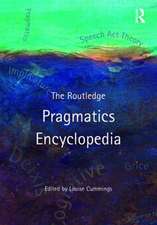The Semantics of the Modal Auxiliaries (RLE Linguistics B: Grammar): Routledge Library Editions: Linguistics
Autor Jennifer Coatesen Limba Engleză Hardback – 21 noi 2013
| Toate formatele și edițiile | Preț | Express |
|---|---|---|
| Paperback (1) | 436.14 lei 6-8 săpt. | |
| Taylor & Francis – 11 dec 2015 | 436.14 lei 6-8 săpt. | |
| Hardback (1) | 1001.84 lei 6-8 săpt. | |
| Taylor & Francis – 21 noi 2013 | 1001.84 lei 6-8 săpt. |
Din seria Routledge Library Editions: Linguistics
-
 Preț: 340.60 lei
Preț: 340.60 lei - 18%
 Preț: 1000.27 lei
Preț: 1000.27 lei - 18%
 Preț: 1002.63 lei
Preț: 1002.63 lei - 15%
 Preț: 671.56 lei
Preț: 671.56 lei - 18%
 Preț: 1002.63 lei
Preț: 1002.63 lei - 18%
 Preț: 1002.63 lei
Preț: 1002.63 lei - 18%
 Preț: 999.46 lei
Preț: 999.46 lei - 18%
 Preț: 777.70 lei
Preț: 777.70 lei - 34%
 Preț: 4327.12 lei
Preț: 4327.12 lei - 18%
 Preț: 1003.43 lei
Preț: 1003.43 lei - 15%
 Preț: 636.01 lei
Preț: 636.01 lei - 18%
 Preț: 1000.27 lei
Preț: 1000.27 lei - 34%
 Preț: 4048.76 lei
Preț: 4048.76 lei - 18%
 Preț: 1061.06 lei
Preț: 1061.06 lei - 18%
 Preț: 1061.81 lei
Preț: 1061.81 lei - 18%
 Preț: 781.64 lei
Preț: 781.64 lei - 18%
 Preț: 780.87 lei
Preț: 780.87 lei - 18%
 Preț: 891.85 lei
Preț: 891.85 lei - 18%
 Preț: 1001.84 lei
Preț: 1001.84 lei - 18%
 Preț: 1054.71 lei
Preț: 1054.71 lei - 18%
 Preț: 1001.84 lei
Preț: 1001.84 lei - 18%
 Preț: 1343.56 lei
Preț: 1343.56 lei - 18%
 Preț: 781.64 lei
Preț: 781.64 lei - 34%
 Preț: 5440.48 lei
Preț: 5440.48 lei - 18%
 Preț: 1002.80 lei
Preț: 1002.80 lei - 15%
 Preț: 670.77 lei
Preț: 670.77 lei - 34%
 Preț: 2378.63 lei
Preț: 2378.63 lei - 18%
 Preț: 1060.25 lei
Preț: 1060.25 lei - 18%
 Preț: 1005.01 lei
Preț: 1005.01 lei - 18%
 Preț: 1000.27 lei
Preț: 1000.27 lei - 34%
 Preț: 1821.92 lei
Preț: 1821.92 lei - 18%
 Preț: 1002.63 lei
Preț: 1002.63 lei - 18%
 Preț: 1282.82 lei
Preț: 1282.82 lei - 18%
 Preț: 1062.62 lei
Preț: 1062.62 lei - 18%
 Preț: 1059.45 lei
Preț: 1059.45 lei - 18%
 Preț: 780.87 lei
Preț: 780.87 lei - 18%
 Preț: 1059.45 lei
Preț: 1059.45 lei - 18%
 Preț: 1001.07 lei
Preț: 1001.07 lei -
 Preț: 330.87 lei
Preț: 330.87 lei - 18%
 Preț: 1168.37 lei
Preț: 1168.37 lei - 18%
 Preț: 1060.25 lei
Preț: 1060.25 lei - 18%
 Preț: 1000.27 lei
Preț: 1000.27 lei - 18%
 Preț: 999.46 lei
Preț: 999.46 lei - 18%
 Preț: 1285.98 lei
Preț: 1285.98 lei - 15%
 Preț: 671.56 lei
Preț: 671.56 lei - 18%
 Preț: 1956.17 lei
Preț: 1956.17 lei - 34%
 Preț: 1293.09 lei
Preț: 1293.09 lei
Preț: 1001.84 lei
Preț vechi: 1221.75 lei
-18% Nou
Puncte Express: 1503
Preț estimativ în valută:
191.70€ • 199.76$ • 158.73£
191.70€ • 199.76$ • 158.73£
Carte tipărită la comandă
Livrare economică 03-17 aprilie
Preluare comenzi: 021 569.72.76
Specificații
ISBN-13: 9780415723817
ISBN-10: 0415723817
Pagini: 272
Dimensiuni: 156 x 234 x 16 mm
Greutate: 0.5 kg
Ediția:1
Editura: Taylor & Francis
Colecția Routledge
Seria Routledge Library Editions: Linguistics
Locul publicării:Oxford, United Kingdom
ISBN-10: 0415723817
Pagini: 272
Dimensiuni: 156 x 234 x 16 mm
Greutate: 0.5 kg
Ediția:1
Editura: Taylor & Francis
Colecția Routledge
Seria Routledge Library Editions: Linguistics
Locul publicării:Oxford, United Kingdom
Cuprins
1. Introduction 1.1. The Data 1.2. A Corpus-Based Approach 1.3. Assessment of Research Goals and Techniques 1.4. The Modal Auxiliaries 1.5 Notation 2. Theoretical Considerations 2.1. Monosemy versus Polysemy 2.2. A Model for Modal Meaning 2.3. Indeterminacy 2.4. Epistemic and Non-epistemic Modality 2.5. Corpus Analysis 3. General Findings and Semantic Clusters 3.1. The Modals: General Findings 3.2. Semantic Clusters 4. The Modals of Obligation and Necessity: MUST, NEED, SHOULD and OUGHT 4.1. MUST 4.2. NEED 4.3. HAVE GOT TO and HAVE TO 4.4. SHOULD 4.5. OUGHT 4.6. SHOULD and OUGHT: Further Issues 5. The Modals of Ability and Possibility: CAN and COULD 5.1. CAN 5.2. COULD 5.3. BE ABLE TO 6. The Modals of Epistemic Possibility: MAY and MIGHT 6.1. MAY 6.2. MIGHT 6.3. Epistemic COULD 6.4. Summary of MIGHT and COULD 7. The Modals of Volition and Prediction: WILL and SHALL 7.1. WILL (including ‘ll and won’t) 7.2. SHALL 7.3. BE GOING TO 8. The Hypothetical Modals: WOULD and SHOULD 8.1. WOULD 8.2. SHOULD and Hypothetical Meaning 8.3. The Modals in Real Conditions 8.4. The Modals in Unreal Conditions 9. Conclusions 9.1. Reappraisal of Certain Issues 9.2. Patterns Revealed by the Data 9.3. Summary of Main Findings 9.4. Conclusion
Descriere
The analysis of a corpus of a ‘real’ language brings the analyst face-to-face with a problem which has frequently been avoided or ignored in theoretical semantics: language is not an orderly phenomenon, and, as far as meaning is concerned, indeterminacy seems to be a feature of all languages. But it is one thing to recognise the existence of indeterminacy, and another to deal with it adequately. Semantic analysis conventionally consists in distinguishing one meaning from another, in recognising discrete categories, but the acknowledgement of indeterminacy explicitly denies the existence of such discrete categories. This book examines in detail this problem and its relationship to a study of modals.




















